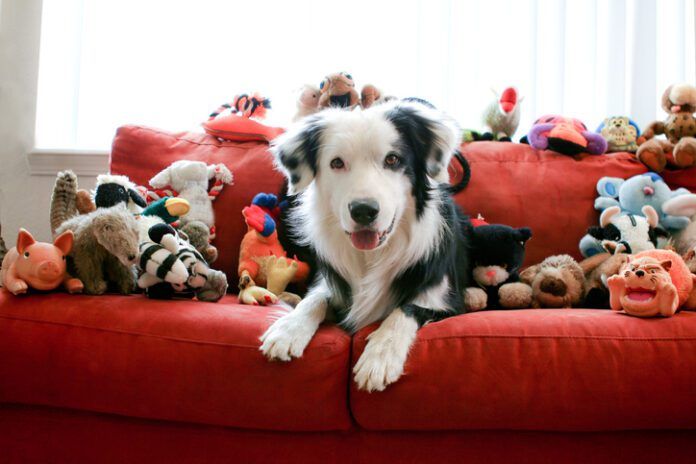Are you tired of finding dog toys strewn across your house? You can teach your canine pal to pick up his toys using “shaping” and “back-chaining.” Shaping involves breaking a behavior into very small steps. You train starting with the smallest step and build to the full behavior. Back-chaining links a series of behaviors together, starting at the end of the chain and working backward. Here’s how to use these training techniques to teach your dog to put his toys away:
- Select a receptable for your dog’s toybox. Put his toys in it and place it in an accessible spot.
- Pick up a favorite toy and hold it over the center of the box. When he glances at it, “mark” the behavior with a reward marker, such as the click of a clicker or a verbal marker (such as the word “Yes!”) and then give him a treat.
- Continue to mark and treat any attention to the toy, very gradually raising the criteria for which behavior you mark and treat. For example, after several repetitions of marking and rewarding your dog for glancing at the toy, hold out for a few moments longer, waiting for your dog to move his nose toward the toy a little – then mark and reward that. After he does that a few times, hold out for a little more movement toward the toy. Eventually he’ll touch the toy for a mark and treat. (For more guidance on this, see “Raising Criteria,” below.)
- When he consistently touches his nose to the toy, raise the criteria again. Now he must open his mouth a little. Then a bit more, and more, until he takes the toy in his mouth.
- Next, let go of the toy when he takes it. Mark, and when he drops the toy to take the treat – Voila! – it drops into the toybox. Milestone!
- Begin adding a toybox-specific cue such as “Clean up!” just before you offer the toy, continuing to repeat Step 5.
Now for the back-chaining part:
- After numerous repetitions of Step 6, gradually move the toy closer to the edge of the box. As you get close to the edge of the box, only mark/treat if the toy actually lands in the box. You’re helping your dog realize he must get the toy in the box to earn his treat.
- When he’ll deliberately move the toy to make sure it lands in the box, offer it just outside the box edge, then gradually farther away from the box.
- When he’ll drop the toy in the box from a few feet away, begin offering the toy to your dog with the toy held close to the floor, eventually setting it on the floor before you give your “Clean up!” cue.
- Last step – add a second toy, then a third and more, until he’ll pick up all his toys and put them away for you.
Congratulations, you’ve done it!
Be sure to slowly raise the criteria that earn your dog a mark and reward. If you raise criteria too quickly, your dog no longer gets reinforce; he’ll think the game is over and will likely quit. Behaviors that aren’t reinforced extinguish, and you don’t want to do that!
It’s helpful to write out a shaping plan with many small increments in the program. Attain multiple repetitions at each step in the plan, and when you are ready to raise criteria, do it on an intermittent schedule of reinforcement. This means that when your dog offers his Step One behavior, you don’t mark, but rather wait to see if he offers a little more. If he does, mark and treat the “more” behavior, and then go back and mark/treat several repetitions of Step One before holding out again for a little more. Raising criteria gradually and continuing to randomly reinforce the lower-level behavior keeps your dog engaged and working. That’s what you need and want.






